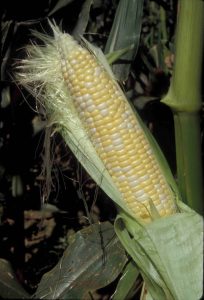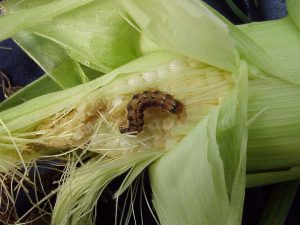Sweet Corn IPM Newsletter No. 8 – August 17, 2018
 Sweet Corn IPM Newsletter No. 8 – August 17, 2018
Sweet Corn IPM Newsletter No. 8 – August 17, 2018
Click on photos to enlarge.
FALL ARMYWORM, CORN EARWORM PRESSURE HIGH
Growers Report Difficulty Controlling Fall Armyworm
SITUATION
Warm weather continued to push corn development this week. Late-planted fields are mostly silking, and will be ready for the post-Labor Day market. We have had several cases of growers finding worm-infested ears in corn that either has been sprayed, or had not yet had a spray recommendation based on pheromone trap captures and field scouting. The damage appears to be from fall armyworm. We may have a type that is not well-matched to the pheromone bait we are using, and may have more tolerance to the pesticides that are typically being used.
European corn borer: Moth activity increased at some sites this week, threatening silking corn in those fields. The five moths per week threshold was exceeded in Biddeford, one Dayton site, one Lewiston site, and Sabattus. However, all of these sites, except for Sabattus, were also under a spray interval for corn earworm, which should also protect against corn borer. Feeding damage was very light, with no sites over the 15% spray threshold for pre-tassel to silking corn.

Corn earworm: Moths caught in traps were generally more widespread and in higher numbers this week, and sprays were recommended for nearly all silking fields. A 6-day spray interval for all silking corn was recommended for Corinth, one Lewiston site, Oxford, Palmyra and one site in Wells. A 5-day spray interval was recommended for Biddeford, Levant and New Gloucester. A 4-day spray interval was recommended for silking fields in Cape Elizabeth, Charleston, Dayton, one Lewiston site, North Berwick, Nobleboro, Wayne and one Wells site.
Fall armyworm: Moth captures continue to be sporadic around the state, but are generally increasing and more widespread. Our fields in Biddeford, Cape Elizabeth, Corinth, Dayton, New Gloucester, Nobleboro, Oxford, Poland Spring and Wells were all over the three moths per week spray threshold for silking corn; but all of the sites were already on a recommended spray interval for corn earworm, with the exception of Poland Spring. With several farms now reporting infested ears at sites where few, if any moths were caught, we are recommending that growers protect any tassel-silking corn that has not yet been sprayed. It may be that the pheromone being used in our traps is not working well with the moths that have come into the state this year. As we reported last week, fall armyworm has been the most challenging species to trap in the past, and in some years the traps have not adequately predicted the damage we found to the ears. Growers are also reporting some infestation regardless of spraying, suggesting that the materials being used in the sprays are not performing well. We recommend that if you have seen problems with insecticide efficacy, you try changing the chemistry of the products you are using. For example, if you have using only synthetic pyrethroids (Warrior®, Bifenthrin®, group 3A), you should try a product in another chemical group, such as Coragen® or Belt SC® (Group 28). Evening sprays may also be more effective as the larvae tend to be more active and exposed at night.
On younger corn, fall armyworm damage was over the 15% control threshold in Biddeford and New Gloucester, although most sites had larvae feeding.
Sincerely,
David T. Handley
Vegetable and Small Fruit Specialist
Highmoor Farm, P.O. Box 179, 52 US Route 202, Monmouth, ME 04259, 207.933.2100
UMaine Extension Diagnostic Research Lab, Pest Management Unit, 17 Godfrey Drive, Orono, ME 04473, 1.800.287.0279
| Location | CEW Moths |
ECB Moths |
FAW Moths |
%Feeding Damage |
Recommendations / Comments |
|---|---|---|---|---|---|
| Biddeford | 6 | 6 | 22 | 28% | 5-day spray interval recommended on all silking corn |
| Bowdoinham | 1 | 0 | 0 | 2% | No spray recommended |
| Cape Elizabeth | 9 | 2 | 6 | 3% | 4-day spray interval recommended on all silking corn |
| Charleston | 8 | 0 | 0 | 4-day spray interval recommended on all silking corn | |
| Corinth | 2 | 0 | 8 | 0% | 6-day spray interval recommended on all silking corn |
| Dayton I | 32 | 6 | 5 | 2% | 4-day spray interval recommended on all silking corn |
| Dayton II | 15 | 0 | 0 | 8% | 4-day spray interval recommended on all silking corn |
| Farmington | 0 | 3 | 0 | 0% | No spray recommended |
| Levant | 5 | 0 | 2 | 1% | 5-day spray interval recommended on all silking corn |
| Lewiston I | 22 | 0 | 2 | 4-day spray interval recommended on all silking corn | |
| Lewiston II | 2 | 5 | 0 | 6-day spray interval recommended on all silking corn | |
| New Gloucester | 7 | 1 | 9 | 18% | 5-day spray interval recommended on all silking corn |
| North Berwick | 38 | 0 | 0 | 3% | 4-day spray interval recommended on all silking corn |
| Nobleboro | 23 | 2 | 6 | 9% | 4-day spray interval recommended on all silking corn |
| Oxford | 2 | 0 | 6 | 5% | 6-day spray interval recommended on all silking corn |
| Palmyra | 2 | 2 | 0 | 0% | 6-day spray interval recommended on all silking corn |
| Poland Spring | 0 | 0 | 3 | 11% | One spray for FAW on all silking corn |
| Sabattus | 1 | 19 | 0 | One spray for ECB on all silking corn | |
| Wayne | 9 | 0 | 0 | 4-day spray interval recommended on all silking corn | |
| Wells I | 3 | 0 | 0 | 6% | 6-day spray interval recommended on all silking corn |
| Wells II | 32 | 3 | 5 | 10% | 4-day spray interval recommended on all silking corn |
CEW: Corn earworm (Only fresh silking corn should be sprayed for this insect.)
ECB: European corn borer
FAW: Fall armyworm
| Moths caught per week | Moths caught per night | Spray interval |
|---|---|---|
| 0.0 to 1.4 | 0.0 to 0.2 | No spray |
| 1.5 to 3.5 | 0.3 to 0.5 | Spray every 6 days |
| 3.6 to 7.0 | 0.6 to 1.0 | Spray every 5 days |
| 7.1 to 91 | 1.1 to 13.0 | Spray every 4 days |
| More than 91 | More than 13 | Spray every 3 days |
Thresholds apply only to corn with exposed fresh silk. Lengthen spray intervals by one day if maximum daily temperature is less than 80°F.
European Corn Borer Thresholds
Whorl stage: 30% or more of plants scouted show injury.
Pre-tassel-silk: 15% or more of plants scouted show injury.
Silk: 5 or more moths caught in pheromone traps in one week.
IPM Web Pages:
UMaine Cooperative Extension Integrated Pest Management
UMass Amherst Integrated Pest Management
Where brand names or company names are used, it is for the reader’s information. No endorsement is implied nor is any discrimination intended against other products with similar ingredients. Always consult product labels for rates, application instructions and safety precautions. Users of these products assume all associated risks.
The University of Maine is an equal opportunity/affirmative action institution.
